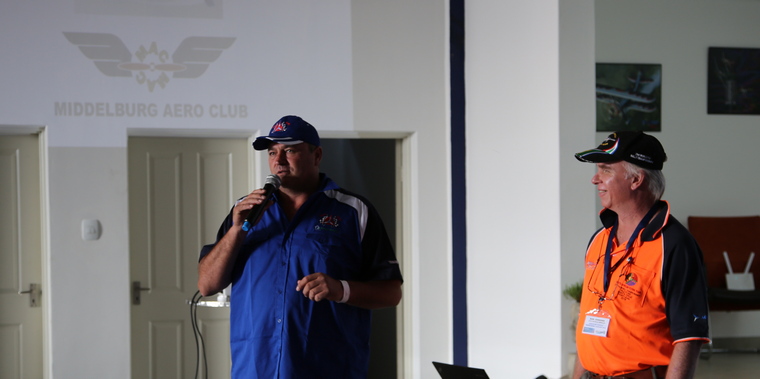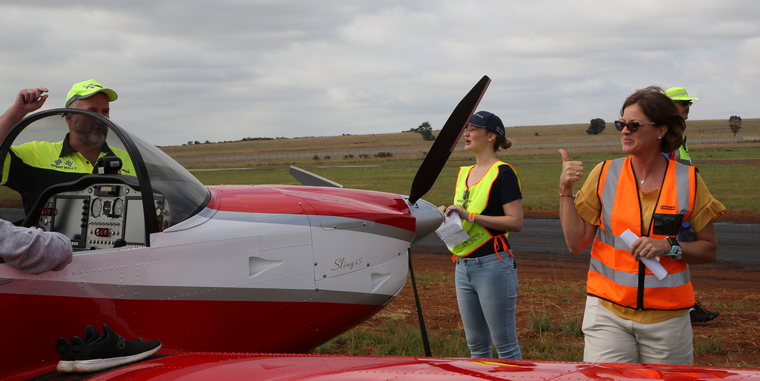The Pilot Insure Middelburg Navigation Speed Rally - 9 March 2019
By Rob Jonkers. Photos by Cheryl Smit
The South African Power Flying Association held a very successful Speed Rally at the Aero Club Airweek 2019 at Middelburg. Originally scheduled as an Adventure Rally as was held in 2018, SAPFA decided to change this to a Speed Rally given the popularity of the event, with this one being the 4th in the series.
Within days of the announcement, the first 28 places were snapped up by competitors having taken part in the previous events, not leaving any room for new entrants and it was decided to extend the field from the original maximum of 30 to 35, with an opportunity for the local Middelburg club members to take part. This event is one that is flown at full speed under handicap conditions and the course is around 120 nm long, has 11 or so turning points, with each turning point identified with a correct photograph.
Planning got underway in February to prepare the route, keeping in mind that with the Airweek as an event and an Airshow to coordinate with, in terms of take-off and landing slots of other arrivals and departures made the details challenging to plan. The route was kept to the north and east of the airfield, as most inbound and outbound traffic would be from the west.
Friday saw a fairly full day of test flights with some repeat test flights to reconfirm handicaps, with conditions mostly favourable although the cloud base was low in the morning. After the Safety Aviator Presentations which started just after 2 pm, Mary de Klerk had arranged to hold a training session on how to fly a Speed Rally and which was very well attended, and included a practical map preparation session on an example map, sharing the tips and tricks of how to follow the map features and timing points.


Thereafter at 6h30, Jonty Esser as the Race Master introduced Rob Jonkers who took to the stage and provided a briefing on what to expect for the next day in terms of the planned route, how many turnpoints, distance, departure and arrivals protocol and also how the scoring system would world work with expected weather conditions, which looked as if it would be good.


Then all the competitors were treated to a briefing on Steroids on Friday night with the Speed Rally Race Master Jonty Esser having set up a show for the teams with a real life lights, camera, action sequence where each team were introduced with their team theme song and handed their race numbers. Jonty also introduced the teams to the Speed Rally website where a Speed Rally ranking system was created with team profiles and their leaderboard position.
The evening ended with a braai hosted by the Middelburg Aero Club, before retiring for the night. Some were camping under the wing or in Neil Bowden's tent area. Saturday morning saw low cloud and some fog although it started to lift and clear fairly soon, giving a go ahead to start the rally.
The briefing started at 8h30, which was a shortened version just to cover the basics of the route, radio procedures and weather. With the briefing over teams prepared their aircraft, with marshals assisting in parking sequence while the organisers got the papers ready. Each team would then receive an envelope with a map, turnpoint photos, a minute marker and a GPS logger to record their track. Aircraft were then also scrutineered with all portable electronic devices sealed up in bags and although no onboard systems were disabled, it relied on an honour code to not utilise onboard GPS as a Navigation aid. The course is was however designed in such a manner that GPS would be of minimal benefit.

The Rally line up getting ready to start
 
 
The intent is that everybody uses the basic skills of navigation plotting and flying and operate as a team in terms of cockpit workload, and with the course layout boasting short legs it for sure makes the crew resource work sharing all the more important. The idea would be that each crew would receive a pre-plotted map already complete with the route, turning points, headings and altitudes where the map would not have any lat/long or grid references. This would be provided 20 minutes prior take-off to allow route orientation and the plotting of minute markers.

 

In this format, there are two objectives:- fly against a pre-determined handicap speed for each aircraft fly the shortest route around the course which would consist of a minimum of 10 turning points. Any aircraft would be able to compete, from slower LSA aircraft to the fast turbo singles or twins. The idea would be to test the speed capability and navigation skills of each crew against each other, where the most accurate flying and turn performance management would win the rally.



The scrutineers checking for illegal aids
Scrutineers Chareen, Lizelle, Jean, Conrad, Frans and David were on hand to seal up all portable GPS capable devices, and also handing out papers at the allotted time time while simultaneously also checking that the fuel tanks were full. To assist the teams at getting their take-off roll accurate, a starting colour panel was used which was set up next to the start line on the runway by Chief Marshal Hans Potgieter and Mark Clulow, which would release them at their allotted time slot. Each team then received their envelopes with their loggers at their 20 minute prior to take-off time, and then taxi to the starting line within 10 minutes of take-off time. 1st take-off was at 09h55 for the slowest aircraft and last take-off at 10h50 with a planned arrival at 11h30. It was calculated that the fast Cirrus ZS-ACA would only need 40 minutes to complete the course.
With all the competitors off towards the north, the route had a mix of easy and challenging turnpoints to contend with to give competitors a chance to always be aware of where of their posistions. Some turnpoints were a challenge find, especially if the colour of the surrounding ground features had changed since the photos were taken. Although Turnpoint 2 was essentially along the road going past the airfield, it was still difficult to find apparently given how many were searching for it. Quite a few competitors cut the corners on turn points including Phil & Mary who during her training session warned everybody to "go round the TP".




After all teams having returned and safe on the ground, the scoring team got to work to analyse the results, and with the new loggers, were able to complete the scores by 1 pm, after which everyone was given their score sheets. Prize giving would only be in the evening so the teams and officials could enjoy the Airshow for the afternoon.
With everybody settling in for the VIP dinner hosted by the Middelburg Aero Club and opening speeches and starters enjoyed by the guests, the prize giving was coordinated by Jonty Esser acting as the MC for this time slot. Firstly aircraft judging certificates handed out by EAA's Sean Cronin and thereafter a showing of a number of interesting flight tracks given by Rob Jonkers which for this rally turned out overall to be very good, with only one competitor having had some navigation trouble and for sure the overall standard is improving, with all aircraft over the line within 7 minutes. As the teams were visible approaching the field, first in view was Jonty Esser in the slowest aircraft a Foxbat being chased down by Phil Wakeley in a C210, who crossed the line within 8 seconds of each other. Some other interesting facts were that the full field also completed the course with an average of 7 nm overflown and the best performance against handicap time was 25 seconds.
After this the Speed Rally promo video was shown after which prize giving commenced and which was hosted by Frans Smit from Pilot Insure who was this Speed Rally's main sponsor. First a Hard Luck certificate was handed out to Jaco Goosen whose C182 fell into a subterranean aardvark tunnel and damaged the horizontal stabilizer after which Jonty handed over the Club Trophy to Richardt Lovett and the Middelburg team.

The winning track - ZU-DYE

Having a bad day, but not bad considering the good recovery - ZU-LAX
The overall winners in the best handicap speed were the team of Jonty Esser and Jonathan Esser in a Foxbat ZU-DYE. Second place was Arthur de Kock and Freddie van Rooyen in their Jabiru J430 ZU-MEL while Hendrik Loots and Jandre Loots bagged the final step of the podium in their Sling 2 ZU-IHK. The first fourteen placings were the only crews who managed a clean penalty free round.
The winners in the accuracy category were the team of David Ross and James Braid in their Sling 2 ZU-JAR. Second place was Johan van Eeden and Cor Esterhuizen in their RV7 ZU-IHH, and in third place the skopgat team of Ron Stirk and Von Hamman in their C150 ZS-IWD.
Many thanks to the Middelburg Aero Club for hosting this fantastic event, the SAPFA team of Hans Potgieter with the ground marshals, Nigel Musgrave as the Safety Officer, Dirk and Louna de Vos and Mark Clulow doing the scoring with our handicapping guru Chester Chandler, Chareen Shillaw, Lizelle Kruger handing out competition papers to the crews and to Jonty & Lizelle for putting together an awesome Friday evening launch event. Also thanks to Mary de Klerk for the time made available to do the training course held on Friday- it sure helped the teams to gain an understanding of what to expect.

A big thanks to Pilot Insure who were the main sponsor of the event, Flightline Weekly for sponsoring the race numbers and also to Pilot's Post for sponsoring the team of Phil Wakeley and Mary de Klerk. Pilot's Post Willie Bodenstein provided three key reasons for why they entered into the sponsorship agreement. The first one being that the Speed Rally is being marketed as a brand and will be seen as the future of competitive flying. The second being that the Speed Rally brand will add value to their brand and thirdly that Pilot's Post believe that Phil and Mary are the perfect ambassadors for their and they will carry their flag high.
The next speed rally is in Bethlehem on the 8th June 2019
|
              |























